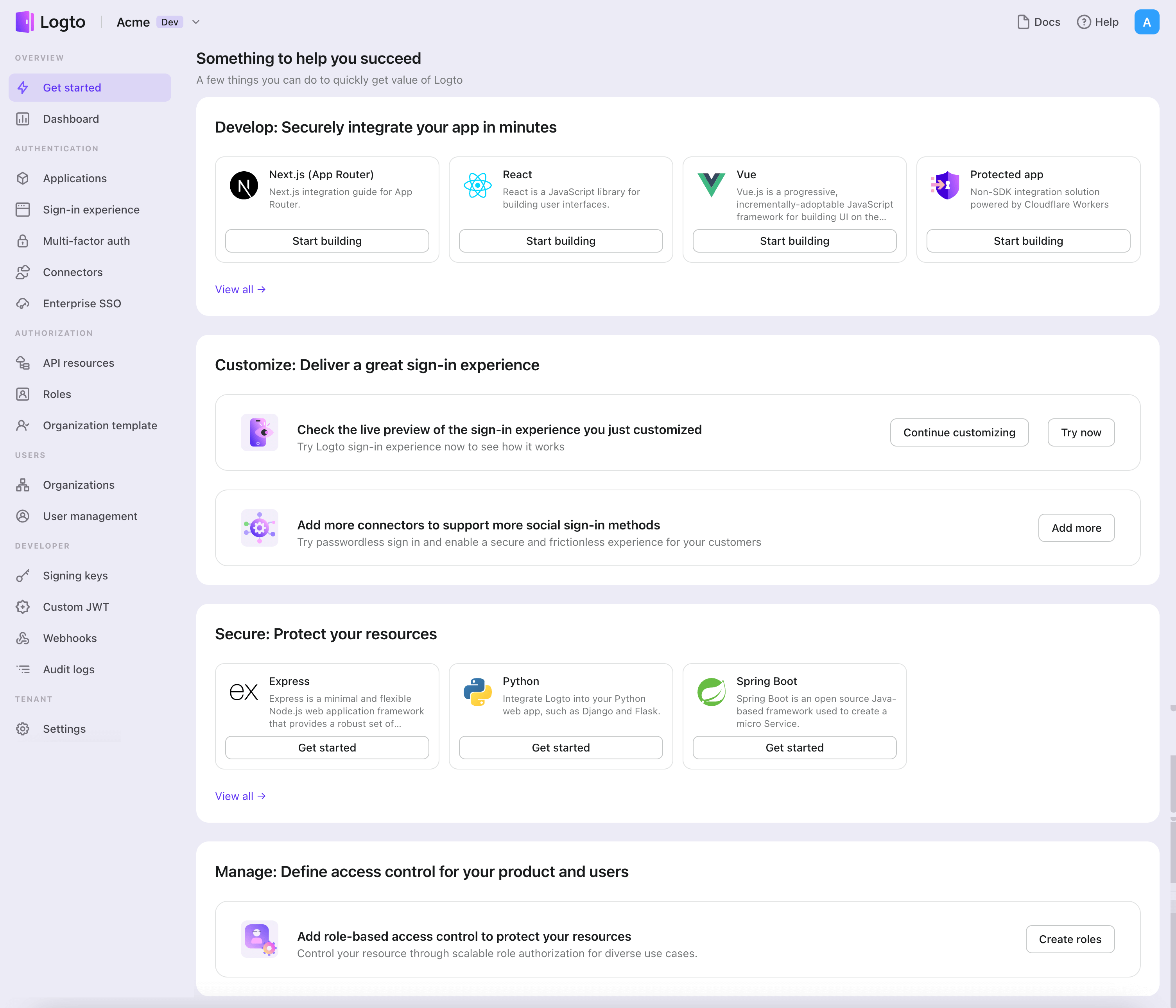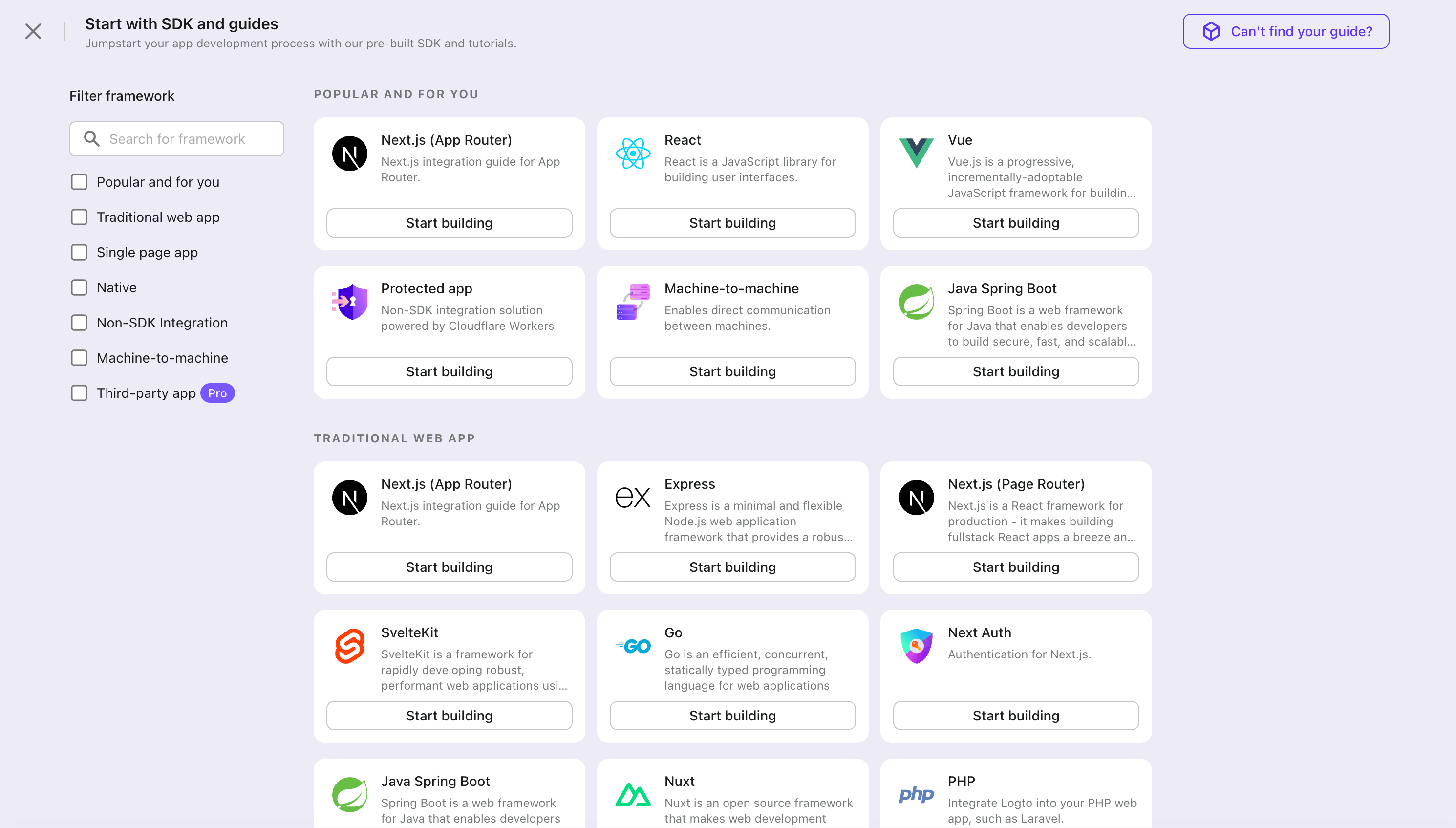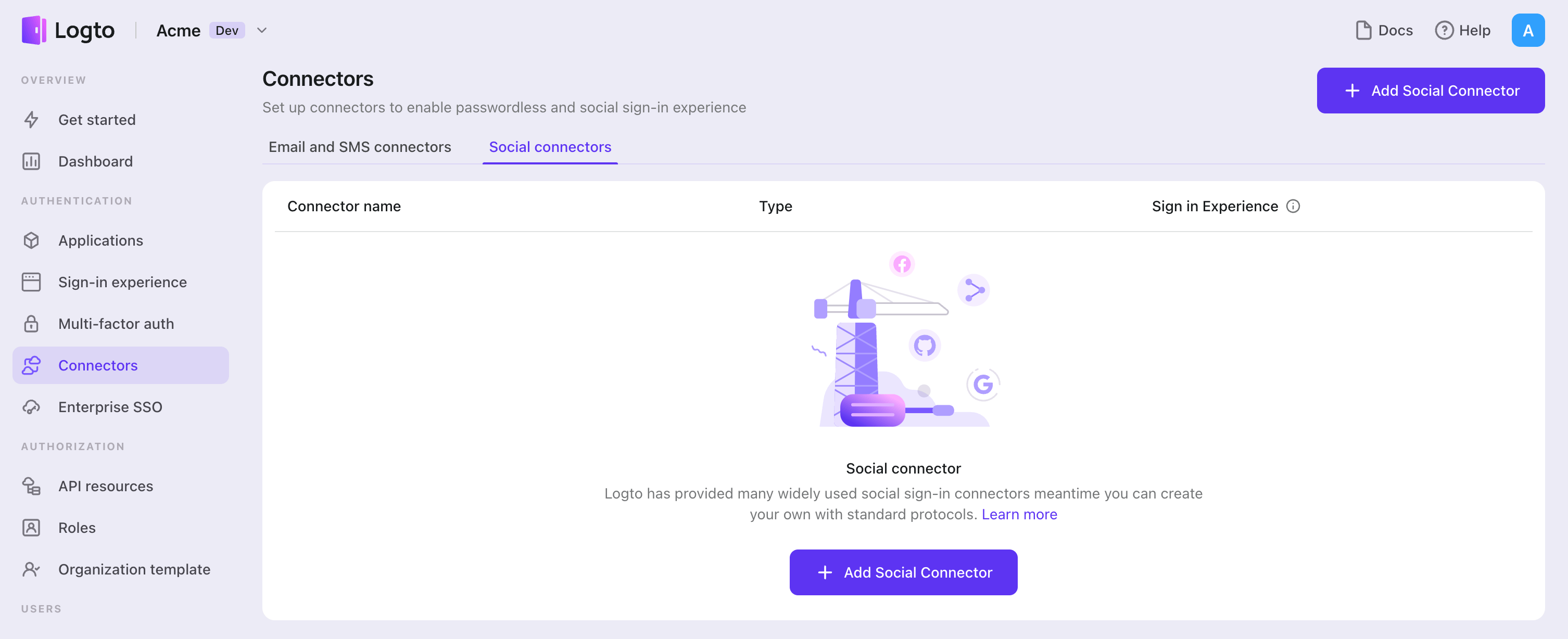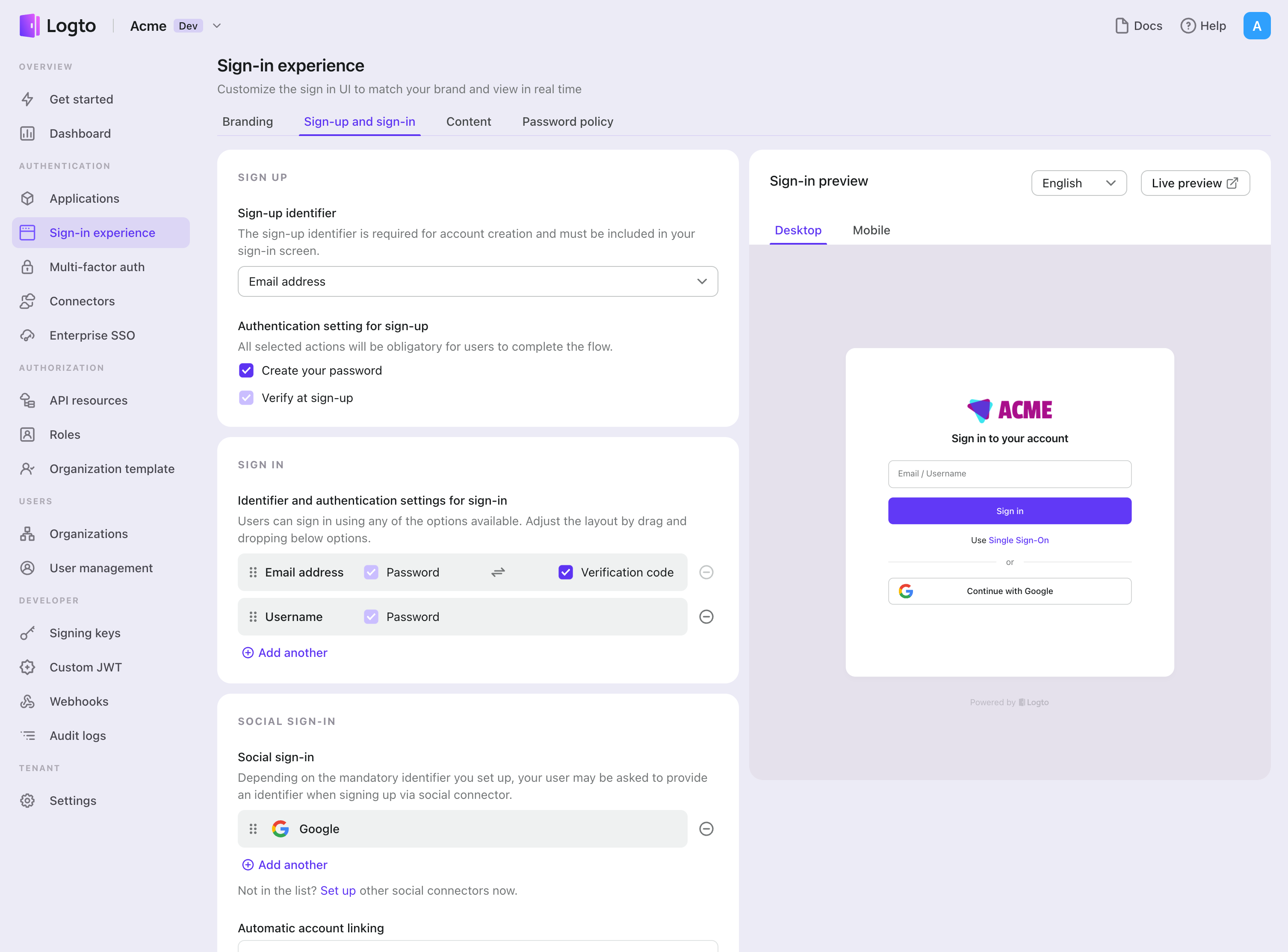Logto is an Auth0 alternative designed for modern apps and SaaS products. It offers both Cloud and Open-source services to help you quickly launch your identity and management (IAM) system. Enjoy authentication, authorization, and multi-tenant management all in one.
We recommend starting with a free development tenant on Logto Cloud. This allows you to explore all the features easily.
In this article, we will go through the steps to quickly build the DingTalk sign-in experience (user authentication) with Expo (React Native) and Logto.
Prerequisites
- A running Logto instance. Check out the introduction page to get started.
- Basic knowledge of Expo (React Native).
- A usable DingTalk account.
Create an application in Logto
Logto is based on OpenID Connect (OIDC) authentication and OAuth 2.0 authorization. It supports federated identity management across multiple applications, commonly called Single Sign-On (SSO).
To create your Native app application, simply follow these steps:
- Open the Logto Console. In the "Get started" section, click the "View all" link to open the application frameworks list. Alternatively, you can navigate to Logto Console > Applications, and click the "Create application" button.

- In the opening modal, click the "Native app" section or filter all the available "Native app" frameworks using the quick filter checkboxes on the left. Click the "Expo" framework card to start creating your application.

- Enter the application name, e.g., "Bookstore," and click "Create application".
🎉 Ta-da! You just created your first application in Logto. You'll see a congrats page which includes a detailed integration guide. Follow the guide to see what the experience will be in your application.
Integrate Expo with Logto
- The following demonstration is built on Expo ~50.0.6.
- The sample project is available on our SDK repository.
Installation
Install Logto SDK and peer dependencies via your favorite package manager:
- npm
- Yarn
- pnpm
npm i @logto/rn
npm i expo-crypto expo-secure-store expo-web-browser @react-native-async-storage/async-storage
yarn add @logto/rn
yarn add expo-crypto expo-secure-store expo-web-browser @react-native-async-storage/async-storage
pnpm add @logto/rn
pnpm add expo-crypto expo-secure-store expo-web-browser @react-native-async-storage/async-storage
The @logto/rn package is the SDK for Logto. The remaining packages are its peer dependencies. They couldn't be listed as direct dependencies because the Expo CLI requires that all dependencies for native modules be installed directly within the root project's package.json.
If you're installing this in a bare React Native app, you should also follow these additional installation instructions.
Init Logto provider
Import and use LogtoProvider to provide a Logto context:
import { LogtoProvider, LogtoConfig } from '@logto/rn';
const config: LogtoConfig = {
endpoint: '<your-logto-endpoint>',
appId: '<your-application-id>',
};
const App = () => (
<LogtoProvider config={config}>
<YourAppContent />
</LogtoProvider>
);
Implement sign-in and sign-out
Before we dive into the details, here's a quick overview of the end-user experience. The sign-in process can be simplified as follows:
- Your app invokes the sign-in method.
- The user is redirected to the Logto sign-in page. For native apps, the system browser is opened.
- The user signs in and is redirected back to your app (configured as the redirect URI).
Regarding redirect-based sign-in
- This authentication process follows the OpenID Connect (OIDC) protocol, and Logto enforces strict security measures to protect user sign-in.
- If you have multiple apps, you can use the same identity provider (Logto). Once the user signs in to one app, Logto will automatically complete the sign-in process when the user accesses another app.
To learn more about the rationale and benefits of redirect-based sign-in, see Logto sign-in experience explained.
Switch to the application details page of Logto Console. Add a native redirect URI (for example, io.logto://callback), then click "Save".
-
For iOS, the redirect URI scheme does not really matter since the
ASWebAuthenticationSessionclass will listen to the redirect URI regardless of if it's registered. -
For Android, the redirect URI scheme must be filled in Expo's
app.jsonfile, for example:app.json{
"expo": {
"scheme": "io.logto"
}
}
Now back to your app, you can use useLogto hook to sign in and sign out:
import { useLogto } from '@logto/rn';
import { Button } from 'react-native';
const Content = () => {
const { signIn, signOut, isAuthenticated } = useLogto();
return (
<div>
{isAuthenticated ? (
<Button title="Sign out" onPress={async () => signOut()} />
) : (
// Replace the redirect URI with your own
<Button title="Sign in" onPress={async () => signIn('io.logto://callback')} />
)}
</div>
);
};
Checkpoint: Test your application
Now, you can test your application:
- Run your application, you will see the sign-in button.
- Click the sign-in button, the SDK will init the sign-in process and redirect you to the Logto sign-in page.
- After you signed in, you will be redirected back to your application and see the sign-out button.
- Click the sign-out button to clear token storage and sign out.
Add DingTalk connector
To enable quick sign-in and improve user conversion, connect with Expo as an identity provider. The Logto social connector helps you establish this connection in minutes by allowing several parameter inputs.
To add a social connector, simply follow these steps:
- Navigate to Console > Connectors > Social Connectors.
- Click "Add social connector" and select "DingTalk".
- Follow the README guide and complete required fields and customize settings.

If you are following the in-place Connector guide, you can skip the next section.
Set up DingTalk OAuth app
Create a web app in the DingTalk Open Platform
Tips: You can skip some sections if you have already finished.
Register a DingTalk developer account
If you do not have a DingTalk developer account, please register at the DingTalk Open Platform.
Create an application
- In the DingTalk Open Platform "Application Development" > "Internal Enterprise Application" > "DingTalk Application", click "Create Application"
- Fill in the application name and description, and click "Save"
- In the left navigation bar, select "Development Configuration" > "Security Settings", find and configure the "Redirect URL"
${your_logto_origin}/callback/${connector_id}. You can find theconnector_idon the connector details page after adding the respective connector in the management console - In the left navigation bar, select "Basic Information" > "Credentials and Basic Information" to get the
Client IDandClient Secret
Configure permissions
In "Development Configuration" > "Permission Management", select Contact.User.Read and Contact.User.mobile permissions and authorize them
Release Application
In the left navigation bar, select "Application Release" > "Version Management and Release", create and release the first version to activate the Client ID and Client Secret
If the application does not release a version, the obtained "Client ID" and "Client Secret" cannot be used, or requests will fail.
Configure your connector
Fill out the clientId and clientSecret fields with Client ID(formerly AppKey and SuiteKey) and Client Secret(formerly AppKey and SuiteKey) you've got from OAuth app detail pages mentioned in the previous section.
scope currently supports two values: openid and openid corpid. openid allows obtaining the user's userid after authorization, while openid corpid allows obtaining both the user's id and the organization id selected during the login process. The values should be space-delimited. Note: URL encoding is required.
Config types
| Name | Type |
|---|---|
| clientId | string |
| clientSecret | string |
| scope | string |
Test DingTalk connector
That's it. The DingTalk connector should be available now. Don't forget to Enable connector in sign-in experience.
Once DingTalk web connector is enabled, you can sign in to your app again to see if it works.
Please ensure strict compliance with the usage specifications and development guidelines of the DingTalk Open Platform during the development process.
Support
If you have any questions or need further assistance, please visit the DingTalk Developer Documentation or contact DingTalk technical support.
Save your configuration
Double check you have filled out necessary values in the Logto connector configuration area. Click "Save and Done" (or "Save changes") and the DingTalk connector should be available now.
Enable DingTalk connector in Sign-in Experience
Once you create a social connector successfully, you can enable it as a "Continue with DingTalk" button in Sign-in Experience.
- Navigate to Console > Sign-in experience > Sign-up and sign-in.
- (Optional) Choose "Not applicable" for sign-up identifier if you need social login only.
- Add configured DingTalk connector to the "Social sign-in" section.

Testing and Validation
Return to your Expo (React Native) app. You should now be able to sign in with DingTalk. Enjoy!
Further readings
End-user flows: Logto provides a out-of-the-box authentication flows including MFA and enterprise SSO, along with powerful APIs for flexible implementation of account settings, security verification, and multi-tenant experience.
Authorization: Authorization defines the actions a user can do or resources they can access after being authenticated. Explore how to protect your API for native and single-page applications and implement Role-based Access Control (RBAC).
Organizations: Particularly effective in multi-tenant SaaS and B2B apps, the organization feature enable tenant creation, member management, organization-level RBAC, and just-in-time-provisioning.
Customer IAM series Our serial blog posts about Customer (or Consumer) Identity and Access Management, from 101 to advanced topics and beyond.